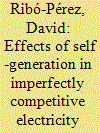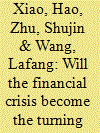|
|
|
Sort Order |
|
|
|
Items / Page
|
|
|
|
|
|
|
| Srl | Item |
| 1 |
ID:
116989


|
|
|
|
|
| Publication |
2012.
|
| Summary/Abstract |
Russia is one of the world's major sources of carbon based energy as well as one its most intensive users. Introducing carbon taxes can lead to a reduction in emissions and encourage investment in energy efficiency. We investigate the economic effects of carbon taxes on the Russian economy under perfect competition and a Cournot oligopoly in output markets. The main findings are: (i) substituting carbon taxes for labour taxes can yield a strong double dividend in Russia; however, welfare gains strongly depend on the labour supply elasticity and elasticities of substitution between capital, labour, and energy. (ii) Under the assumption of a Cournot oligopoly with homogenous products and symmetric firms in the markets for natural gas, petroleum and chemical products, metals, and minerals, welfare costs of the environmental tax reform can be higher than under perfect competition. This is because introducing carbon taxes leads to a reduction in already sub-optimal output, thereby exacerbating pre-existing distortions arising from imperfect competition. (iii) Furthermore, increases in energy costs can result in higher mark-ups in some markets because of less competition resulting from firms' exit.
|
|
|
|
|
|
|
|
|
|
|
|
|
|
|
|
| 2 |
ID:
168654


|
|
|
|
|
| Summary/Abstract |
Domestic rooftop photovoltaic (PV) energy can reduce net electricity demand, and therefore reduce energy prices through a merit-order effect. This reduces profits of all incumbents in the electricity markets. In addition, in imperfectly competitive markets, PV self-generation reduces prices through a reduction in market power. The first effect may warrant additional policy interventions to maintain cost recovery, but the second is much more desirable, as it simultaneously helps increase sustainability and competition. However, unlike a simple reduction in market prices, the competition effect affects all incumbents differently. Since resistance from incumbents can be a significant barrier to energy policy change, it is important to understand the distribution of effects. This paper does so for the Spanish market. A Nash-Cournot model and a simplified representation of the Spanish electricity market is used to determine the merit-order and competition effects of an increase in solar self-generation. We conclude that both are important, and that their analysis is essential to inform the social debate around PV policy.
|
|
|
|
|
|
|
|
|
|
|
|
|
|
|
|
| 3 |
ID:
096622


|
|
|
|
|
| Publication |
2010.
|
| Summary/Abstract |
This paper evaluates the impact of intermittent wind generation on hourly equilibrium prices and output, using data on expected wind generation capacity and demand for 2020. Hourly wind data for the period 1993-2005 are used to obtain wind output generation profiles for thirty regions (onshore and offshore) across Great Britain. Matching the wind profiles for each month to the actual hourly demand (scaled to possible 2020 values), we find that the volatility of prices will increase, and that there is significant year-to-year variation in generators' profits. Above-average wind speeds lead to below-average prices, but annual revenues for British wind generators (producing more in the winter) are almost as great as for base-load generators. In the presence of significant market power (the equivalent of two symmetric firms owning fossil-fuelled capacity, rather than six), the level of prices more than doubled, and their volatility increased. However, wind generators' average revenues rose by 20% less than those of base-load plant.
|
|
|
|
|
|
|
|
|
|
|
|
|
|
|
|
| 4 |
ID:
097463


|
|
|
|
|
| Publication |
2010.
|
| Summary/Abstract |
This paper evaluates the impact of intermittent wind generation on hourly equilibrium prices and output, using data on expected wind generation capacity and demand for 2020. Hourly wind data for the period 1993-2005 are used to obtain wind output generation profiles for thirty regions (onshore and offshore) across Great Britain. Matching the wind profiles for each month to the actual hourly demand (scaled to possible 2020 values), we find that the volatility of prices will increase, and that there is significant year-to-year variation in generators' profits. Above-average wind speeds lead to below-average prices, but annual revenues for British wind generators (producing more in the winter) are almost as great as for base-load generators. In the presence of significant market power (the equivalent of two symmetric firms owning fossil-fuelled capacity, rather than six), the level of prices more than doubled, and their volatility increased. However, wind generators' average revenues rose by 20% less than those of base-load plant.
|
|
|
|
|
|
|
|
|
|
|
|
|
|
|
|
| 5 |
ID:
093652


|
|
|
|
|
| Publication |
2009.
|
| Summary/Abstract |
Following the substantial damage from the financial crisis in 2008, can China's auto industry successfully take up new challenges and grasp the opportunities ahead? First and foremost, this paper summarises the ways that the financial crisis has impacted upon China's economy. By analysing the impacts based on the MCHUGE model, the paper concludes that reductions in export demand and consumption expectations have limited impact on China's auto industry, while the comparative reduction in investment expectations has a great impact on China's auto industry. The paper builds the MCHUGE model with imperfect competition in order to assess whether China's auto industry, characterised as an oligopoly, could successfully accept such a challenge. The conclusion of this paper indicates that the damage to China's auto industry caused by the financial crisis would appear even more serious if the static effect of an oligopoly was the only consideration. Finally, by simulating the implementation of the Revitalisation Plans of the Automobile Industry, it is concluded that the revitalisation policy aims to boost auto consumption and will thus bring new opportunities for China's auto industry; on the other hand, the mergers and acquisitions between and among auto industries, as well as the relevant potential technology progress and the popularisation of new energy automobiles, will further promote the development of China's auto industry.
|
|
|
|
|
|
|
|
|
|
|
|
|
|
|
|
|
|
|
|
|